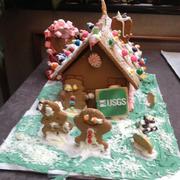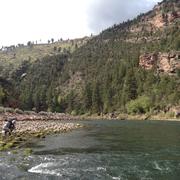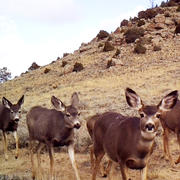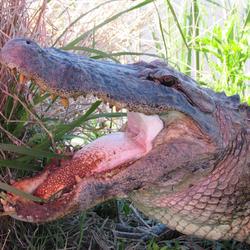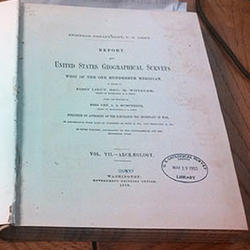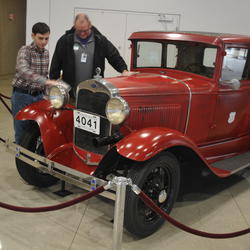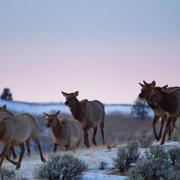Due to a lapse in appropriations, the majority of USGS websites may not be up to date and may not reflect current conditions. Websites displaying real-time data, such as Earthquake and Water and information needed for public health and safety will be updated with limited support. Additionally, USGS will not be able to respond to inquiries until appropriations are enacted. For more information, please see www.doi.gov/shutdown
Cooperative Research Units
Home
Programs L2 Landing Page
Established in 1935, our mission is our hallmark: meet the actionable science needs of our cooperators, provide technical assistance, and develop the future workforce through graduate education/mentoring. The Coop Units are located on 40 universities in 38 states. They are called Coop Units because each cooperator plays a role in the staffing, funding and directing the units.
Find out more about CRUsThe Cooperative Fish and Wildlife Research Unit (CRU) Program had a productive year in 2016. Despite vacancies in our scientist ranks exceeding 20 percent, our research, training, and teaching portfolio was full and we graduated 93 students and published 398 manuscripts primarily focused on addressing the real conservation challenges of our cooperators.
CRU ScienceRestoring Whooping Cranes to Southwest Louisiana: A Cooperative Venture
Researchers from the Louisiana Cooperative Research Unit evaluated habitat suitability at White Lake, Louisiana, for the possible reintroduction of endangered whooping cranes. The information collected led to the 2011-2012 release of 40 cranes. Researchers are continuing to monitor the reintroduced cranes and more releases are planned.
Metapopulation Dynamics of the Adélie Penguin
The Oregon Cooperative Unit, graduate students, and a group of U.S. and international collaborators are conducting long-term research on the Adélie penguin on Ross Island, Antarctica. This species depends on sea ice (obligate) and in some regions of Antarctica is being affected by climate change’s influence on sea ice patterns.
Unit scientists develop programs and applications to be used by State and Federal managers to conduct data analyses to inform decision making. The Colorado Unit co-authored the textbook “Bayesian Models: A Statistical Primer for Ecologists.” The Arizona Unit developed a simple, web-based tool to compare freshwater fish data collected using American Fisheries Society standard methods.
Avian point count survey-specific data in Northern New England 2013 to 2015
Avian point count, vegetation, and management data from surveys in Northern New England at four National Wildlife Refuges (NWRs), Baxter State Park, and prviate lands in Northern Maine surveyed during the breeding and postbreeding season bewteen 1 June and 4 August 2013 to 2015. NWRs include Nulhegan (Silvio O. Conte), Umbagog, Moosehorn, and Aroostook. This data release includes five zip...
Habitat and fish field survey data from Wyoming Range streams in 2012 and 2013
Stream habitat characteristics, energy development metrics, and fish catch per unit effort data for 91 sites (100m stream reach) sampled in the summers of 2012 and 2013.We sampled four streams in the Dry Piney Drainage (Dry Piney, Beaver Dam, Black Canyon, and North Black Canyon), five in the Fogarty Drainage (North and South Fogarty, North and South Pine Grove, and Sawmill) and four in the...
Fish collection and hydrological data for oxbows in western Iowa
The data set associated with this metadata is included in three separate csv files: 'Occupancy_Data', 'Stage_Raw', and 'Flood_Stage_Height'. 'Occupancy_Data' was used to fit the dynamic occupancy models and includes 17 columns: Time: time periods numbered 1 to 5; 'Oxbow': individual oxbows numbered 1 through 10; 'OxbowName': the name of each oxbow; 'Species': species encountered during...
Activity patterns of cave-dwelling bat species during pre-hibernation swarming and post-hibernation emergence in the central Appalachians
Bat activity around known hibernacula in Virginia and West Virginia portion of the central Appalachians during the fall swarm and spring emergence, 2015-2017
Activity patterns in regional and long-distance migrant bat species during the fall and spring along ridgelines in the central Appalachians, 2015-2017
Data contain zero-crossing, frequency acoustic detector locations, date to hour, species of bats recorded and identified and various wind and precipitation values associated with either day or hour for ridges,sideslopes and valleys at 5 locations in western Virginia's Appalachian Mountains.
Amphibian Occupancy and Effects of Habitat Use on Pesticide Exposure in Iowa Wetlands
Amphibians living in agricultural areas encounter many challenges. Two factors affecting individuals in these landscapes are habitat loss and pesticides. This thesis focuses on amphibians using agricultural wetlands in Iowa, where row crops such as corn and soybeans dominate the landscape. The goal of my first study was to determine the influences of site characteristics on amphibian presence...
Standard Methods for Sampling North American Freshwater Fishes
The Arizona Cooperative Fish and Wildlife Research Unit developed a simple, web-based tool to compare freshwater fish data collected using American Fisheries Society standard methods. With widespread use, the tool could become an important resource for fisheries biologists. Check out the video by Scott Bonar, Unit Leader, Arizona Unit...
Composition of diet of juvenile Brown Pelican in the northern Gulf of Mexico (2013-2015)
The Brown Pelican (Pelecanus occidentalis) is a large-bodied seabird that nests in colonies of 10 to upwards of 5,000 pairs, on nearshore barrier islands in subtropical and tropical North American waters. It breeds between March and August, laying 2–3 eggs and raising 1–2 chicks per year. The species is facultatively migratory during nonbreeding, with some individuals...
Taxonomical identification of Brown Pelican prey in the northern Gulf of Mexico (2013-2015)
The Brown Pelican (Pelecanus occidentalis) is a large-bodied seabird that nests in colonies of 10 to upwards of 5,000 pairs, on nearshore barrier islands in subtropical and tropical North American waters. It breeds between March and August, laying 2–3 eggs and raising 1–2 chicks per year. The species is facultatively migratory during nonbreeding, with some individuals...
Proximate Density Composition of Brown Pelican prey in the northern Gulf of Mexico (2014-2015)
The Brown Pelican (Pelecanus occidentalis) is a large-bodied seabird that nests in colonies of 10 to upwards of 5,000 pairs, on nearshore barrier islands in subtropical and tropical North American waters. It breeds between March and August, laying 2–3 eggs and raising 1–2 chicks per year. The species is facultatively migratory during nonbreeding, with some individuals...
Brown pelican foraging ecology in the northern Gulf of Mexico (2013-2015)_Colony reference
The Brown Pelican (Pelecanus occidentalis) is a large-bodied seabird that nests in colonies of 10 to upwards of 5,000 pairs, on nearshore barrier islands in subtropical and tropical North American waters. It breeds between March and August, laying 2–3 eggs and raising 1–2 chicks per year. The species is facultatively migratory during nonbreeding, with some individuals...
Provisioning rate of Brown Pelican in the northern Gulf of Mexico (2014-2015)
The Brown Pelican (Pelecanus occidentalis) is a large-bodied seabird that nests in colonies of 10 to upwards of 5,000 pairs, on nearshore barrier islands in subtropical and tropical North American waters. It breeds between March and August, laying 2–3 eggs and raising 1–2 chicks per year. The species is facultatively migratory during nonbreeding, with some individuals...
USGS Cooperative Fish and Wildlife Research Units: 2017 Year In Review
In September 1960, the 86th Congress passed Public Law 86-686 to facilitate cooperation between the Federal government, colleges and universities, the States, and private organizations for Cooperative Unit Programs of research and education relating to fish and wildlife, and for other purposes. The Cooperative Research Units originated in the U.S. Department of Agriculture in the mid 1930s
2016 Cooperative Research Unit Story Map
In this Year in Review report, you will find details on staffing, vacancies, research funding, and other pertinent information. You will also see snapshots of Unit projects with information on how results have been or are being applied by cooperators. That is the essence of what we do: science that matter.
2015 Cooperative Research Units Story Map
The Cooperative Research Unit mission is our hallmark: meeting the actionable science needs of our cooperators, providing them technical guidance and assistance in interpreting and applying new advances in science, and developing the future workforce through graduate education and mentoring.
Chapter 2. The North American carbon budget: Past, present, and future
This chapter nicely summarizes and synthesizes the latest scientific information on the North American carbon budget by incorporating terrestrial, anthropogenic, aquatic, and coastal margin CO2 and CH4dynamics. Starting with a historical context, the chapter summarizes current understanding of the magnitudes and trends of carbon stocks and...
McGuire, A. David; Hayes, Daniel J.; Vargas, Rodrigo; Alin, Simone R.; Conant, Richard T.; Hutrya, Lucy R.; Jacobson, Andrew R.; kurz, Werner A.; Poulter, Benjamine; Woodall, Christopher W.; Liu, ShuguangRegenerating clearcuts combined with postharvest forestry treatments promote habitat for breeding and post-breeding spruce-fir avian assemblages in the Atlantic Northern Forest
The quantity of spruce-fir forest and some conifer-associated breeding bird abundances in the Atlantic Northern Forest have declined in recent decades emphasizing the need to better understand avian responses to forest management and to identify options that proactively conserve habitat for birds during the breeding and post-breeding period. We...
Rolek, Brian W.; Harrison, Daniel J.; Loftin, Cynthia S.; Wood, Petra B.Submerged aquatic vegetation mapping in coastal Louisiana through development of a spatial likelihood occurrence (SLOO) model
Determining the spatial distribution of coastal foundation species is essential to accurately determine restoration goals, predict the ecological effects of climate change, and develop habitat management strategies. Mapping the distribution of submerged aquatic vegetation (SAV) species assemblages, which provide important habitat resource and...
DeMarco, Kristin; Couvillion, Brady; Brown, Stuart; La Peyre, MeganArtelle et al. (2018) miss the science underlying North American wildlife management
Artelle et al. (2018) conclude that “hallmarks of science” are largely missing from North American wildlife management based on a desk review of selected hunting management plans and related documents found through Internet searches and email requests to state and provincial wildlife agencies. We highlight three fundamental problems that...
Mawdsley, Jonathan R.; Organ, John F.; Decker, Daniel J.; Forstchen, Ann; Regan, Ronald J.; Riley, Shawn J.; Boyce, Mark S.; Mcdonald, John E.; Dwyer, Chris; Mahoney, Shane P.Stock structure, dynamics, demographics, and movements of walleyes spawning in four tributaries to Green Bay
To test assumptions related to the current conceptual model for walleye Sander vitreusmanagement in Green Bay, we evaluated whether: 1) spawning aggregations in the Fox, Menominee, Oconto, and Peshtigo rivers represent genetically distinct stocks; 2) population dynamics and demographics vary among walleye spawning at these...
Dembkowski, Daniel J.; Isermann, Daniel A.; Hogler, Steven R.; Larson, Wesley; Turnquist, Keith N.Evaluation of anal fin spines, otoliths, and scales for estimating age and back-calculated lengths of yellow perch in southern Green Bay
Southern Green Bay supports important fisheries for yellow perch Perca flavescens and valid estimates of age structure and growth are critical to effective management. Anal fin spines and scales are used by the Wisconsin Department of Natural Resources for age estimation, but these structures may...
Isermann, Daniel A.; Breeggemann, Jason J.; Paroli, Tammie J.A new modeling approach to prioritize riparian restoration to reduce sediment loading in two Virginia river basins
Human impact, particularly land cover changes (e.g., agriculture, construction) increase erosion and sediment loading into streams. Benthic species are negatively affected by silt deposition that coats and embeds stream substrate. Given that riparian buffers are effective sediment filters, riparian restoration is increasingly implemented by...
Scott, Lisa N.; Villamagna, Amy M.; Angermeier, Paul L.Diel fledging patterns among grassland passerines: Relative impacts of energetics and predation risk
The time of day that nestlings fledge from a nest is thought to be shaped by predation risk and energetics. To minimize predation risk, fledging is predicted to start as early in the day as possible so that nestlings can maximize time outside the nest to find a safe place to stay before nightfall. Fledging times are predicted to be tightly grouped...
Ribic, Christine; Ng, Christoph; Koper, Nicola; Ellison, Kevin; Pietz, Pamela J.; Rugg, David J.A values-based private landowner typology to improve grassland conservation initiatives
Many conservation initiatives are based on natural science alone, despite an extensive body of literature demonstrating that the incorporation of social science generates more successful and lasting outcomes. The Land Use Value (LUV) scale is an example of a social science tool that grassland conservation practitioners can use to improve their...
Sweikert, Lily A.; Gigliotti, Larry M.Segmentation of Mississippi’s natural and artificial lakes
Segmentations divide a diverse resource into groups, or segments, based on distinctive attributes that may respond similarly to management actions. A 4-way segmentation based on lake origin (natural or artificial) and size (small or large) was constructed for Mississippi lakes using a 30 yr data set. We aimed to document elements distinguishing...
Miranda, Leandro E.; Bull, L. A.; Colvin, M.E.; Hubbard, W.D.; Pugh, L.L.Chronic wasting disease detection and mortality sources in semi-protected deer population
Surveillance for wildlife diseases is essential for assessing population dynamics of ungulates, especially in free-ranging populations where infected animals are difficult to sample. Chronic wasting disease (CWD) is an emerging infectious disease of concern because of the potential for substantial negative effects on populations of cervids....
Schuler, Krysten L.; Jenks, Jonathan A.; Klaver, Robert W.; Jennelle, Christopher S.; Bowyer, R. TerryClimatically driven changes in primary production propagate through trophic levels
Climate and land‐use change are the major drivers of global biodiversity loss. Their effects are particularly acute for wide‐ranging consumers, but little is known about how these factors interact to affect the abundance of large carnivores and their herbivore prey. We analyzed population densities of a primary and secondary consumer (mule deer,...
Stoner, David C.; Sexton, Joseph O.; Choate, David M.; Nagol, Jyothy; Bernales, Heather H.; Sims, Steven A.; Ironside, Kirsten E.; Longshore, Kathleen M.; Edwards, Thomas C.Unit scientists routinely develop programs and applications to be used by State and Federal natural resource managers to conduct data analyses to inform decision making.
Wildlife Software and Models
A suite of software tools and models developed by Colorado State University and the USGS Colorado Cooperative Fish And Wildlife Research Unit.
monitoR: Acoustic template detection in R
Tools for automated acoustic monitoring of nature.
Fishery Information and Technology Software
Software from the American Fisheries Society
R for Fisheries and Wildlife Applications
FW599: An introduction to data management and R for Fisheries and Wildlife applications--- a lighthearted look
InVEST: 18 different models for ecosystem services
The InVEST tool allows researchers to evaluate relationships between land management actions and wild bee populations.
Under the guidelines of the Cooperative Research Agreement, CRU is required to communicate with funders, cooperators, stakeholders, and the public. CRU maintains outreach pathways and participation among state, federal, university, and private researchers.
Canada Lynx
– Scientists at the USGS Massachusetts Cooperative Fish and
Wildlife Research Unit at the University of Massachusetts Amherst, in
collaboration with The Rockefeller University’s Vertebrate Genome Laboratory,
New York, are releasing to a public repository at the vertebrate lab, for use by
geneticists, conservationists and other researchers around the
Alligator Hatchlings
Crocodilians are one of the few reptile taxa that exhibit parental care. In alligators, following nest construction, females stay nearby in a guard hole, and are known to defend their nests against predators or other intruders. At the end of the 60-day incubation period, alligator hatchlings will vocalize from within the egg, to signal to the mother that they are ready to
...American Alligator
USGS and other scientists have studied in-depth alligator populations in Florida and Louisiana, but basic ecological knowledge is lacking for populations at the northern edge of their range. For example, differences in climate and habitat between the southern and northern portions of the range limit the applicability of findings from other studies to South Carolina
...Largest American Alligator Satellite Telemetry-Tracking Study
South Carolina alligators occupy a patchwork of diverse habitats, including rivers, lakes, wooded swamps, tidal marshes, and impounded freshwater wetlands. As a mobile, opportunistic predator, alligators seasonally adjust their habitat use for feeding. For example, some Florida alligators venture into brackish water habitats to feed on nutrient-rich blue crabs during the
...Golden eagle fitted with Global Positioning System (GPS) backpack
Reports of golden eagle mortality linked to wind energy facilities are cause for concern especially when coupled with the knowledge that golden eagles move great distances between breeding and wintering areas. Mortalities at a particular wind energy facility can consequently affect breeding populations of golden eagles at local and continent-wide scales. Information is
...A student volunteer scans historic USGS library material
Student volunteers are trained to scan historic library materials. The materials can be complex, consisting of multiple parts.
Oklahoma Cooperative Fish and Wildlife Research Unit Student with Black Bear Cub
The USGS Oklahoma Cooperative Fish and Wildlife Research Unit teams are capturing and marking black bears in the Ozark and Ouachita regions of Oklahoma.
In the Driver’s Seat
Student dusts the Model A Ford coupe used by USGS scientists from the 1930s to 1965.
USGS Volunteer Student at the Smithsonian Natural History Museum
The Smithsonian Natural History Museum offers hands-on learning experiences.
Student volunteer works in the USGS libraries map collection
Student volunteer explores the historic USGS map collection.
Pallid Sturgeon
The pallid sturgeon is an endangered riverine sturgeon with historical distribution restricted to parts of the Yellowstone, Missouri, Mississippi, and Atchafalaya Rivers. Although rare, pallid sturgeon in the lower Mississippi River appear to be naturally recruiting, and information about habitat use is important to conserve this species. This study seeks to provide
...The USGS provides 2-5 PhD level research scientists that sit on the graduate faculty at their host university; the host university provides office and lab space and administrative support; and the state natural resource agency(s) provide base operating funds to their unit. In addition the state and university cooperators have direct involvement in the staffing of and research conducted by the Unit
Upcoming EventsResearch to Recover Threatened Waterfowl: USGS Cooperative Fish and Wildlife Research Unit Supervisor Receives Prestigious U.S. Fish and Wildlife Service Recovery Champion Award
USGS scientist James “Barry” Grand, Ph.D., has been named a 2016 U.S. Fish and Wildlife Service Recovery Champion (Region 7) for his exemplary long-term research on two formerly threatened species, the spectacled eider and Alaska-breeding Steller’s eiders.
Migrating mule deer track “green waves” of spring forage: study highlights importance of habitat corridors for migrating game and other species
Migratory mule deer in Wyoming closely time their movements to track the spring green-up, providing evidence of an underappreciated foraging benefit of migration, according to a study by University of Wyoming and U.S. Geological Survey scientists at the Wyoming Cooperative Fish and Wildlife Research Unit.
A Grand Slam for Students, Schools and Science
"It’s a grand slam for all involved,” said Dawn Childs, USGS Cooperative Fish and Wildlife Research Units. “Recent high school graduates with special needs get real-world experience while helping USGS scientists on projects ranging from grizzly bears and energy to historic documents and bird migration. And a school system gets to successfully train students to enter the workforce."
Wild Turkey Talk
A group of turkeys is referred to as either a rafter or a gang. So this Thanksgiving, when celebrating with your own gang, remember the turkey as more than just the main course, but, as Benjamin Franklin said so many years ago, as a noble fowl of American tradition.
Hot off the Press! Great Balls of Fire!
The USGS Nebraska Cooperative Fish and Wildlife Research Unit in partnership with the Nebraska Intelligent MoBile Unmanned Systems Lab (NIMBUS) and the Applied Complex Adaptive Systems Lab have designed a drone prototype that drops balls filled with combustible material that ignites fire as part of prescribed fire management.
Happy Mother’s Day to Moms of All Species
USGS wishes to honor all mothers, of all species. Many of our research findings have and are shedding light on the lives of non-human moms.
Shorebirds Ignore Aircraft, But Pay Attention to People, Off-road Vehicles
The American oystercatchers studied on Cape Lookout National Seashore in North Carolina were disturbed more by pedestrians and off-road vehicles passing their nests than the U.S. military aircraft flying overhead.
Continued Decline of the Northern Spotted Owl Associated with the Invasive Barred Owl, Habitat Loss, and Climate Variation
CORVALLIS, Ore. – Northern spotted owl populations are declining in all parts of their range in the Pacific Northwest, according to research published in The Condor. Based on data from 11 study areas across Washington, Oregon and northern California, a rangewide decline of nearly 4 percent per year was estimated from 1985 to 2013.
Endangered Flying Squirrel Relegated to Living on Sky-Islands
Habitat loss has fragmented the population of the Carolina northern flying squirrel, an endangered species now living on “sky-islands” on nine isolated mountain peaks in the southern Appalachians.
Wildlife Researchers to Give Public Close-Up, Real-Time View of Big Game Fieldwork
LARAMIE, WY — Seeking insights to help moose, elk, mule deer and bighorn sheep populations, researchers from the University of Wyoming, the Wyoming Game and Fish Department, the U.S. Geological Survey and other partners will spend much of March capturing animals on their winter ranges in western and southern Wyoming.
Culprit Identified in Decline of Endangered Missouri River Pallid Sturgeon
BOZEMAN – Pallid sturgeon come from a genetic line that has lived on this planet for tens of millions of years; yet it has been decades since anyone has documented any of the enormous fish successfully producing young that survive to adulthood in the upper Missouri River basin.
USGS and University of Wyoming Researchers to Share Deer Capture Field Work Via Social Media
Wyoming's struggling mule deer populations are receiving significant attention from University of Wyoming researchers, the Wyoming Game and Fish Department, the U.S. Geological Survey and others, with at least five studies underway that could assist efforts to enhance deer numbers and their habitats.
The cooperative nature of the CRU Program provides the workforce with a familiarity with the needs and policies of State and Federal science and management agencies. The success of this approach is evident in that CRU students have gone on to hold important leadership positions in nearly every State and Federal conservation agency.
CRU Partners






